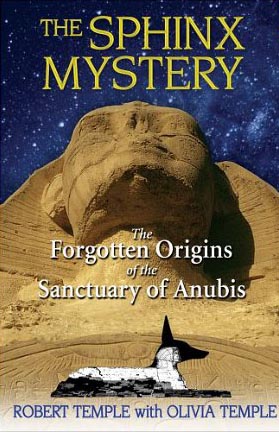 …The Forgotten Origins of the Sanctuary of Anubis
…The Forgotten Origins of the Sanctuary of Anubis
Synopsis (from book cover):
Shrouded in mystery for centuries, the sphinx of Giza has frustrated many who have attempted to discover its original purpose. Accounts exist of the Sphinx as an oracle, as a king’s burial chamber, and as a temple for initiation into the Hermetic Mysteries. Egyptologists have argued for decades about whether there are secret chambers underneath the Sphinx, why the head-to-body ratio is out of proportion, and whose face adorns it.
In The Sphinx Mystery, Robert Temple addresses the many mysteries of the Sphinx. He presents eyewitness accounts, published over a period of 281 years, of people who saw the secret chambers and even went inside them before they were sealed 1926 – accounts that had been forgotten until the author rediscovered them. He also describes his own exploration of a tunnel at the rear of the Sphinx, perhaps used for obtaining sacred divinatory dreams.
Robert Temple reveals that the Sphinx was originally a monumental Anubis, the Egyptian jackal god, and that its face is that of a Middle Kingdom pharaoh, Amenemhet II, which was a later re-carving, In addition, he provides photographic evidence of ancient sluice gate traces to demonstrate that, during the Old Kingdom, the Sphinx as Anubis sat surrounded by a moat filled with water – called Jackal Lake in the ancient Pyramid Texts – where religious ceremonies were held. He also provides evidence that the exact size and position of the Sphinx were geometrically determined in relation to the pyramids of Cheops and Chephren and that it was part of a pharaonic resurrection cult.
Review:
The book presents an interesting and plausible theory that the Sphinx was originally carved as Anubis, the Jackal God and that the monument was original surrounded by water. The author has visited the Giza plateau on numerous occasions and has used his knowledge of the area as it is in recent times along with the accounts of people who excavated and lived in the area from the 1700s – 1800s.
It details how the Giza plan is modeled round ‘the golden mean proportion’. I found the chapter entitled ‘The Golden Angle of Resurrection’ particularly fascinating. It explains how the artworks within the tombs and temples display this proportion.
The book is well researched and fully illustrated with diagrams and sepia photographs taken by the author and older photographs and postcards that the author has collected over the years.
For anyone interested in the pyramids or the sphinx, it will make them look at the area in a new way and challenge the ‘consensus reality’.
My brief review doesn’t do the book justice. More information about the book and the theory, along with all the photographs from the book can be found on the book’s dedicated website:








The question is: will they make it into a movie???
Now that is an interesting prospect
Feel like giving way any spoilers today?
So Robert and Olivia purport that it was originally carved into the shape of Anubis, but there are the worn-but-still clear eyes of a completely human face now – so who’s face do they theorize is in the final carving?
Okay, okay I know…read the book and find out
(Yes – I am totally one of those people that reads the last few pages of a book before I read it, by the way)
Interesting about the proportions…proves how little we actually know as opposed to how much we think we know
The book does go into the more modern face and the conclusion is that it is Amenemhet II. But you really will have to read the book to see how the author comes to that conclusion
Ah, okay Amenemhet is the “final” face of the sphinx, understood now – thanks